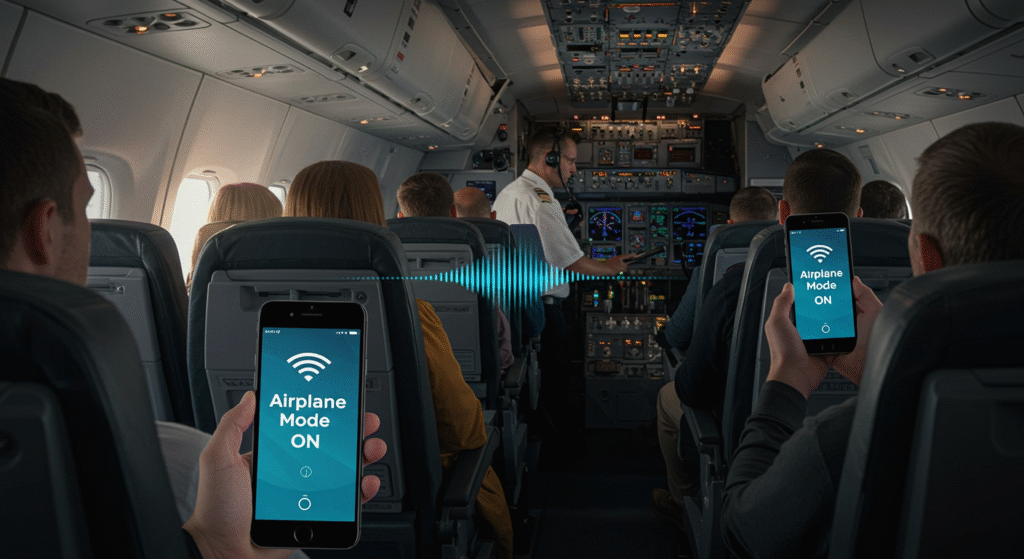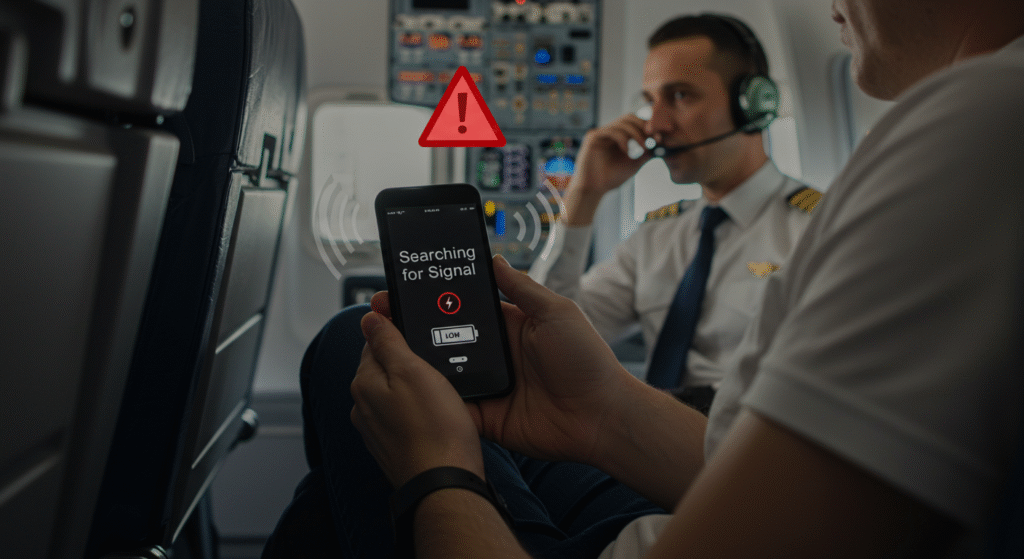
Why Do You Have to Turn on Airplane Mode When Flying?
Imagine this: You’ve just boarded your flight. The seatbelt sign is on, the engines are humming, and a flight attendant gently reminds you,
“Please switch your phone to airplane mode.”
It’s a message we all hear, but many of us don’t truly understand why. Is it just a formality, or is there an important reason behind it?
In this article, let’s explore in simple and clear words why airplane mode is necessary during flights and how it helps keep everyone safer, including you.
What Is Airplane Mode?
Airplane mode is a feature found on almost every smartphone, tablet, and even some laptops. When you turn it on, your device stops sending or receiving any wireless signals. This means it turns off:
- Mobile network – You can’t make phone calls or send text messages.
- Wi-Fi – You can’t connect to the internet using Wi-Fi.
- Bluetooth – Your device won’t connect to Bluetooth gadgets like wireless headphones or smartwatches.
- GPS (partially) – Location services may be limited or turned off.
So basically, your device becomes like an offline gadget. It won’t try to connect to the outside world, which is exactly what airlines want during flights.
But don’t worry your phone or tablet still works! You can watch saved videos, play offline games, read eBooks, take photos, or write notes.
You can turn on airplane mode very easily. Just swipe down your screen to open the quick settings (where Wi-Fi and brightness controls are) and tap the airplane icon. Or go into your phone’s settings and switch it on from there.
It’s quick, simple, and helps make air travel safer for everyone.
Why Is Airplane Mode Important on a Plane?
When you’re flying, the plane is using some very delicate and important communication systems. The pilots constantly talk to air traffic control using radio signals. At the same time, the plane uses special navigation tools to help guide it safely from one place to another.

Now think about this: what if every passenger on the flight left their phone on, trying to connect to mobile networks from the sky that’s hundreds of devices all sending out signals at once.
Even though your phone signal is small, when many phones are doing the same thing, it can create problems like:
- Buzzing or strange sounds in the pilot’s headphones
- Weak or unclear communication between the pilot and control tower
- Possible confusion during critical moments like takeoff or landing
While these problems don’t happen every time, they can happen and even the smallest risk isn’t worth it when lives are involved.
That’s why airlines ask everyone to turn on airplane mode. It’s not just a formality it’s a smart step to help avoid interference and keep the flight as safe as possible for you, the crew, and everyone on board.
What Happens If You Forget to Turn It On?
If you forget to switch your phone to airplane mode, it doesn’t just sit quietly in your pocket. Even when you’re 30,000 feet in the air, your phone keeps working in the background trying to find a mobile signal.

Here’s what can happen when it does that:
- Signal overload: Your phone may try to connect to several cell towers at the same time. This is especially risky during takeoff or landing, when the plane is moving through different network zones quickly.
- Battery drains fast: Since your phone keeps searching for a signal it can’t find, it uses more power than usual. This makes your battery run out faster.
- Interference with pilot communication: The signals from active phones can cause buzzing or clicking sounds in the pilot’s headset. If many passengers leave their phones on, it can disturb important communication between the pilot and air traffic control.
- Expensive roaming charges: If you’re flying over different countries, your phone might try to connect to foreign networks. This can lead to unexpected international roaming charges on your bill.
Even though you might not notice anything wrong on your phone, it could still be causing problems for the pilots and crew and that’s not a risk anyone wants to take while flying.
So, switching on airplane mode isn’t just about following a rule. It’s about helping everyone on the flight stay safe and avoiding unnecessary trouble.
Also Watch :
Is It Just a Rule, or Is It Science?
You might wonder is airplane mode just a rule airlines made up, or is there real science behind it?
The truth is, it’s not a random rule. There’s a scientific reason why airplane mode exists.
Your phone works by sending and receiving radio signals. These signals are used for calls, texts, mobile data, and more. But airplanes also use radio signals for important tasks like talking to air traffic control and using navigation systems.
If many people on the plane leave their phones on, all those signals can clash with the plane’s systems. This doesn’t always cause serious problems, but it can lead to:
- Buzzing or clicking sounds in the pilot’s headset
- Weakened communication signals between the cockpit and air traffic control
- Extra distractions for the crew during important flight moments
Modern aircraft are better at handling interference than older planes, but the risk is still there — especially when dozens or hundreds of devices are active at once.
That’s why aviation experts and safety authorities still recommend using airplane mode. It’s a simple and smart way to reduce any chance of interference.
So no it’s not just a rule. It’s backed by science, safety studies, and real-life reports from pilots around the world.
What Can You Do in Airplane Mode?
Many people think that turning on airplane mode means your phone becomes useless but that’s not true at all. Even when your device is offline, there’s still a lot you can do during your flight.
Here are some things you can enjoy while your phone is in airplane mode:
- 🎬 Watch movies or shows you downloaded earlier from apps like Netflix, Prime Video, or YouTube.
- 🎧 Listen to music or podcasts that are saved on your device perfect for passing the time.
- 🎮 Play games that don’t need the internet. Many mobile games work just fine offline.
- 📚 Read eBooks or saved articles, whether it’s a novel or something you saved to read later.
- 📝 Write notes, journals, or documents use this time to reflect, plan, or even get some work done.
- 📸 Take photos or record videos out the window, of your food, or just for fun.
- 🎧 Use Bluetooth headphones most airlines allow this, so you can still enjoy wireless audio.
Extra Benefit: Save Your Battery
Here’s something you might not expect airplane mode can actually help your phone’s battery last longer.
When your phone isn’t in airplane mode, it keeps searching for mobile networks. This uses a lot of energy, especially when you’re flying high above the ground where there’s no stable signal. But when you turn on airplane mode, your phone stops searching and that saves power.
Another bonus? If you plug in your phone while airplane mode is on, it charges faster because fewer background processes are running.
Even when you’re not on a plane, many people use airplane mode:
- To save battery during the day
- To avoid distractions during meetings, sleep, or study time
- To focus better without calls or notifications
It’s a simple trick with big benefits.
Tips Before You Board
To make the most of your flight, follow these quick tips before activating airplane mode:
- ✅ Download your favorite music, shows, or games
- ✅ Fully charge your phone before leaving
- ✅ Bring a power bank for long flights
- ✅ Carry wired or Bluetooth headphones
- ✅ Turn off mobile data to avoid roaming fees
- ✅ Set an auto-reply if you won’t be checking messages
These small steps can turn your flight into a relaxing and productive time.
Final Words: A Small Action with a Big Purpose
Airplane mode may seem like a tiny switch but it’s a powerful tool. It helps protect flight communication, avoids unnecessary risks, and shows respect for the crew and other passengers.
So next time you fly, don’t ignore that little reminder.
Switch on airplane mode.
Relax, enjoy the view, and fly safe.
Thanks For Visiting primehighlights.com



